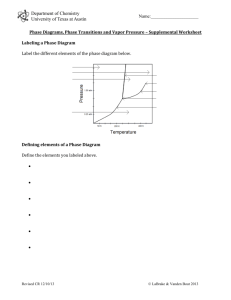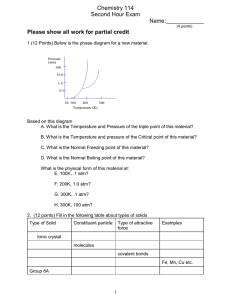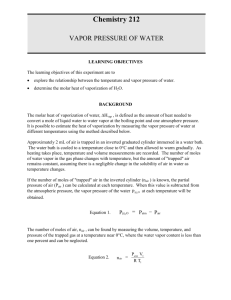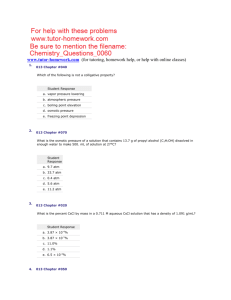Problem Set 3 Solutions 3.20 MIT Professor Gerbrand Ceder
advertisement
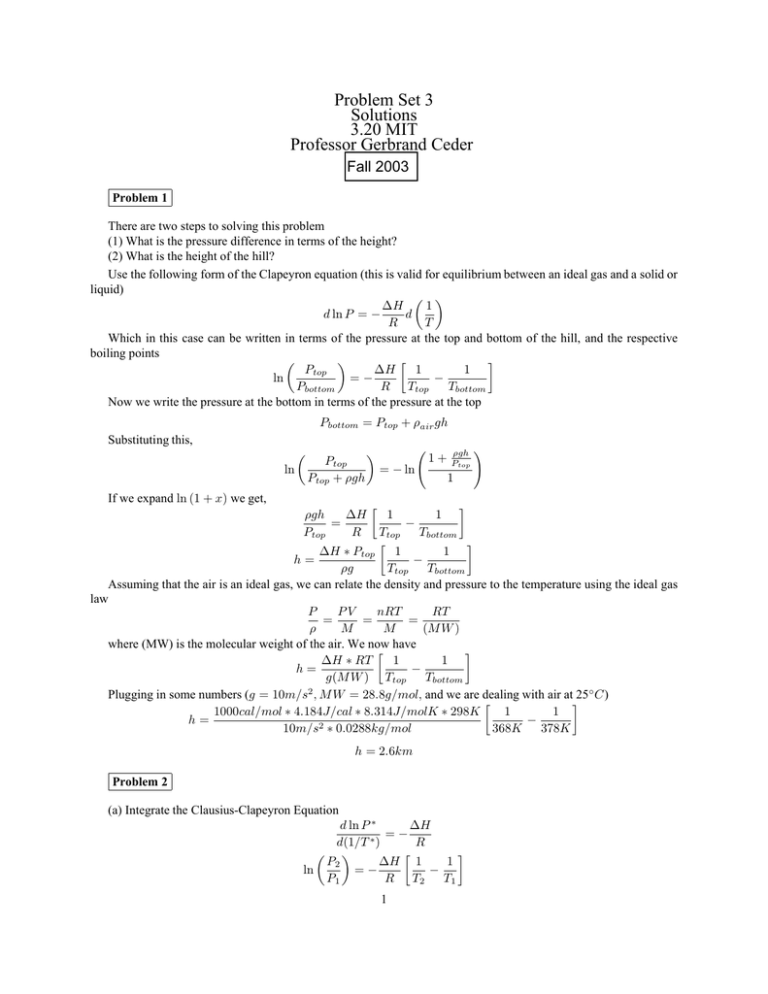
Problem Set 3 Solutions 3.20 MIT Professor Gerbrand Ceder Fall2003 2001 Fall Problem 1 There are two steps to solving this problem (1) What is the pressure difference in terms of the height? (2) What is the height of the hill? Use the following form of the Clapeyron equation (this is valid for equilibrium between an ideal gas and a solid or liquid) H 1 d ln P = d R T Which in this case can be written in terms of the pressure at the top and bottom of the hill, and the respective boiling points Ptop H 1 1 ln = Pbottom R Ttop Tbottom Now we write the pressure at the bottom in terms of the pressure at the top Pbottom = Ptop + air gh Substituting this, ln Ptop Ptop + gh = ln 1+ gh Ptop 1 If we expand ln (1 + x) we get, gh H 1 1 = Ptop R Ttop Tbottom H Ptop 1 1 h= g Ttop Tbottom Assuming that the air is an ideal gas, we can relate the density and pressure to the temperature using the ideal gas law P PV nRT RT = = = M M (M W ) where (MW) is the molecular weight of the air. We now have H RT 1 1 h= g(M W ) Ttop Tbottom 2 Plugging in some numbers (g = 10m/s , M W = 28.8g/mol, and we are dealing with air at 25 C ) 1000cal/mol 4.184J/cal 8.314J/molK 298K 1 1 h= 10m/s2 0.0288kg/mol 368K 378K h = 2.6km Problem 2 (a) Integrate the Clausius-Clapeyron Equation d ln P H = d(1/T ) R P2 H 1 1 ln = P1 R T2 T1 1 For this example, P1 = 1 atm (at boiling), T1 = 1620K,and T2 = 1000K 1 1 156, 000 ln P2 = 8.314 1000 1620 P2 = 7.6 104 atm (b) At the melting point of Li, Psolid = Pliquid 19, 314 1 156, 000 1 13.049 = 8.314 1620 T T 550.5 1.47 = T T = 375K Problem 3 First we can find what the vapor pressure over the liquid would be under these conditions 30671 30671 ln(P ) = + 12.5 = + 12.5 = 7.95 T 1500 P = 3.54 104 atm = 35.8 Pa If all of the silver was in the vapor phase (1 gram) 1 nRT = (8.314) (1500) = 115.61 Pa P = 107.87 V Hence, there must be both liquid and vapor present P = P = 35.8 Pa Now we can find the moles in the vapor phase 35.8 PV = = 2.87 103 moles n= 8.314 1500 RT Grams of vapor 2.87 103 moles (107.87 g/mol) = 0.31g So the fraction in the vapor phase is 0.31 (b) In general the amount of heat necessary would be the sum of the mixing enthalpy and the enthalpy of vaporization Htotal = Hmix + Hvap However, since we are told to assume the solution is ideal, the enthalpy of mixing is zero. (This is related to the assumption that the mixing species do not interact) Thus Q = Htotal = Hvap Since we were not given the enthalpy of vaporization or the boiling point in the data, we must find these quantities. To find the boiling point, use the given equation for the vapor pressure and find the temperature where the pressure is equal to 1 atm. 30671 ln(1) = + 12.5 → Tb = 2454K T To find the heat of vaporization, we can use the integrated form of the Clapeyron equation for an ideal gas. We know the temperature and pressure at two points (from the given equation for vapor pressure) and we can then calculate Hvap. P2 Hvap 1 1 ln = P1 R T2 T1 Choosing T= 1500 and 1600 K, the value calculated for Hvap is 255.kJ/mole. (If you look this up you get 251 kJ/mole) Now we can get the enthalpy of vaporization at 1500K, which can be done using a loop, since we know enthalpy is a state function 2 Hvap(1500K ) = 2454 1500 Cpl dT + Hvap(2454K ) + 1500 2454 Cpg dT 5 Hvap(1500K ) = 33J/molK (2454 1500) + 11, 300J/mol + R(1500 2454) 2 Hvap(1500K ) = 267kJ/mol Problem 4 At 70 C, Ptotal = PN2 + PH2 O = 1atm PH2 O = 0.3atm =⇒ PN2 = 0.7atm After the isothermal volume reduction: PH2 O is still equal to 0.3 atm since PH2 O can not increase since it is the saturation vapor pressure! This will mean that as the volume is being reduced, H2 O will condense, keeping PH2 O at 0.3 atm. PN2 will double RT PN2 = nN2 V V =⇒ PN2 → 2PN2 V → 2 So, Ptotal = 1.4 + 0.3 = 1.7 atm Problem 5 = 1atm at the regular boiling point. (a) The boiling point is where P = Patmosphere . So PH 2O (b) The Clausius-Clapeyron equation allows us to find vapor pressure at some temperature from knowledge of the vapor pressure at another temperature H 1 d d ln P = R T We can integrate this between 373K and 288K 40, 000 1 1 P373 ln = 8.314 373 288 P288 PH (288K ) = 0.021atm 2O Relative humidity is defined as PH2 O PH 2O In this problem the relative humidity is 65% so we can find the PH2 O PH2 O 0.65 = =⇒ PH2 O = 0.0136atm 0.021 . Again we integrate the Clausius-Clapeyron equation, this The dew point is the temperature where PH2 O = PH 2O time solving for T 0.021 40, 000 1 1 ln = 0.0136 8.314 288 T R.H. = T = 281K = 8 C 3 Problem 6 nuc = number of unit cells V = nuc V uc , where V uc is the volume per unit cell V Li nLi = nuc x ∂V ∂ (nuc V uc ) = = ∂nLi ∂ (nuc x) And since nuc is a constant, ∂V uc ∂x This is the slope of the curve given. Thus at x = 1 the partial molar volume of Li is V Li = V Li = 1.15 3 atom Problem 7 The vapor pressure of pure B at 1000 K is 5 104 atm. If B is in an ideal solution with another species at 1000 K, its vapor pressure will be: Higher than 5 104 Lower than 5 104 Equal to 5 104 Impossible to say Problem 8 Reaction to go from non-stoichiometric Li1x N i1+x O2 to LiNiO2 x x Li1x N i1+x O2 + Li2 O + O2 → LiNiO2 + xN iO 2 4 Principle of LeChatleier indicates that a higher PO2 will push the reaction to the right. Problem 9 Once again, we start with the Clausius-Clapeyron equation in this form dP H 1 H dT = → dP = dT V T V T Integrating we get T2 H P2 P1 = ln T1 V Let P1 be the pressure at the original interface (T1 = 5 C ) and P2 be the pressure at the new interface (T2 = 5.2C ) We can also relate the densities to the volume change as follows: s l 1 1 V = l s = l s So, l s T2 P2 P1 = s H ln l T1 Also, we know P1 = P2 + s gh or P2 P1 = s gh Putting this together we get 4 s gh = Solving for the density of the solid, l s H ln s l T2 T1 H T2 ln = 1 gh T1 Putting in the values of the know quantities (being very careful with units) 8371J/kg 267.8K ln s = 1000g/m3 1 9.8m/s2 0.4m 268K s l s = 2.6g/cm3 5
